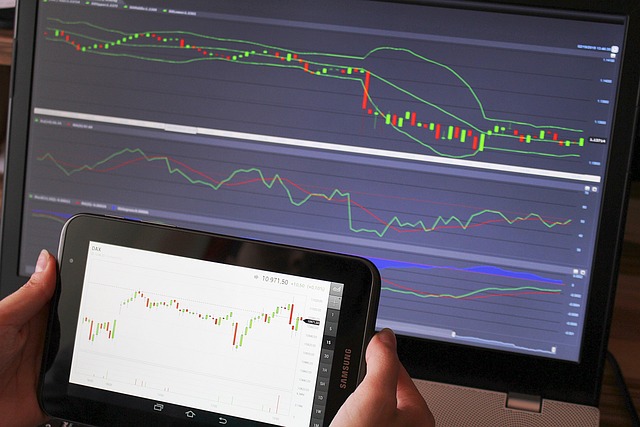Trading Volume Analysis PDF Guide
Author: Jameson Richman Expert
Published On: 2025-10-27
Prepared by Jameson Richman and our team of experts with over a decade of experience in cryptocurrency and digital asset analysis. Learn more about us.
Trading volume analysis pdf is a powerful format for consolidating volume-based market research into a portable, shareable report. This article explains what volume analysis is, which indicators matter most, how to create a professional PDF report (step-by-step), and how to optimize that PDF for search engines and trader audiences. You’ll find practical examples, templates, tools, and links to advanced crypto resources and exchanges so you can generate, validate, and distribute high-quality volume analysis reports.

Why volume matters: the foundation
Volume measures the number of shares, contracts, or coins traded in a period and is a core confirmation tool for price action. High volume on breakouts adds credibility; declining volume during rallies can signal exhaustion. For a formal overview of the financial concept, see the Wikipedia page on volume in finance and Investopedia’s primer on trading volume.
Key volume indicators to include in your PDF
A high-quality trading volume analysis PDF should combine raw volume data with established indicators. Below are the most useful metrics and why to include them.
On-Balance Volume (OBV)
OBV accumulates volume by adding or subtracting volume based on price direction. It's simple and effective for spotting accumulation or distribution trends before price moves.
Volume-Weighted Average Price (VWAP)
VWAP is widely used intraday to show the average price weighted by volume. Institutional traders often use VWAP as a fairness benchmark; including VWAP overlays helps readers understand intraday flow.
Volume Profile / Volume-by-Price
Volume Profile shows traded volume at specific price levels rather than by time. It highlights value areas, acceptance, and rejection zones—essential for order flow context.
Chaikin Money Flow (CMF) and Accumulation/Distribution (A/D)
CMF and A/D blend price and volume to estimate buying vs. selling pressure. These indicators help identify whether volume supports price moves.
Volume Oscillator and Moving Average of Volume
Use short- and long-period moving averages of volume to see surges. A Volume Oscillator (difference between two MAs) highlights volume momentum.
How to read volume signals — patterns and examples
Below are common scenarios and practical interpretations you should document in a trading volume analysis PDF.
- Breakout confirmation: Price breaks resistance with sharply higher volume — likely a valid breakout. If volume is low, treat as suspicious and watch for reversal.
- False breakout / fakeout: Price breaches a level but volume is below average and quickly reverses — often a trap for breakout buyers.
- Trend continuation: In a trending market, volume that increases on trend-day advances and decreases on pullbacks supports continuation.
- Trend reversal: Sharp volume spikes at extremes (with divergence on OBV or CMF) can precede reversals.
- Volume divergence: Price makes a new high but OBV/volume does not — this can point to weakening momentum.
Example: If Ethereum (ETH-USD) prints a new intraday high on 50% higher-than-average volume and VWAP remains below price, the move is likely supported by institutional participation. For current ETH structural views, see a technical outlook for Ethereum.
Ethereum price outlook and volume context

What to include in a trading volume analysis PDF (template)
A professional PDF should be concise, visual, and clearly labelled. Use the following structure as a template:
- Title page: Report title, date/time, instrument(s), author, and version.
- Executive summary: One-paragraph takeaway with trade-ready statements (bias, risk levels, key levels).
- Data sources & methodology: Timeframe, tick vs. aggregated data, source (exchange, API), and indicator settings.
- Raw volume charts: Candles/bars with volume histograms; mark average volume lines.
- Indicator overlays: OBV, VWAP, A/D, CMF, Volume Profile snapshots.
- Annotated trade ideas: Entry, stop, target, confidence rank, and scenario planning.
- Backtest summary: If applicable, short backtest results and edge statistics.
- Appendix: Raw data, code snippets, and references.
Step-by-step: Creating a trading volume analysis PDF
You can create a professional PDF using Excel, Python, or charting platforms like TradingView. Below are step-by-step workflows for different skill levels.
Beginner: Excel + chart export
- Download historical OHLCV (open-high-low-close-volume) from your exchange or data provider.
- Import into Excel, add a moving average of volume column and compute simple indicators (e.g., OBV formula).
- Create charts: price + volume histogram; overlay MA lines on volume panel.
- Annotate charts with shapes/text boxes to mark levels and observations.
- Export charts and the document to PDF via File → Save As → PDF.
Intermediate: Python (pandas, matplotlib, mplfinance) → PDF
Python offers repeatability and automation for periodic reporting.
- Use the exchange API or CCXT to fetch OHLCV data: Binance, MEXC, Bybit, Bitget APIs are common sources.
- Compute indicators with pandas or libraries like ta-lib / pandas-ta (OBV, VWAP, CMF).
- Plot with mplfinance or matplotlib; add Volume Profile using libraries like volumeprofile or custom code.
- Assemble into a multi-page PDF using matplotlib.backends.backend_pdf.PdfPages or ReportLab for richer layout.
For guidance on developing automated crypto trading systems, including bot codebases and optimization, see this expert guide and GitHub resources.
AI crypto trading bot — expert guide and GitHub references
Advanced: TradingView chart snapshots → HTML → PDF
- Create annotated charts in TradingView (volume profile, OBV, custom scripts).
- Take high-resolution chart snapshots or use TradingView’s Charting Library API for automated images.
- Compose an HTML report (responsive) and convert to PDF using wkhtmltopdf or headless Chrome for pixel-perfect output.
Data sources and APIs (reliable feeds)
Quality data matters. Use exchange-provided historical data where possible to ensure volume accuracy, especially for crypto where centralized and decentralized liquidity vary.
- Binance REST and WebSocket APIs — ideal for liquid crypto data. Register here if you need an account: Binance registration.
- MEXC market data — useful for altcoin depth and tick history: MEXC registration.
- Bitget API and Bybit API for derivatives and volume across perpetual markets: Bitget registration, Bybit registration.

Backtesting volume-based rules
To validate a trading edge based on volume, follow these steps and document results in your PDF:
- Define hypotheses (e.g., breakout > resistance + volume > 150% average → win rate X).
- Collect tick-level or 1-minute OHLCV data for a relevant period.
- Implement rule-based system in Python or R and run out-of-sample tests.
- Report metrics: CAGR, max drawdown, Sharpe, win rate, average R, sample size, and p-values for statistical significance.
- Include caveats: data-snooping, survivorship bias, changed market microstructure.
Documenting backtest assumptions in your trading volume analysis PDF increases credibility and reproducibility.
Optimizing PDFs for Google and discovery
If you want your trading volume analysis PDF to be discoverable, treat it like any other piece of SEO content. Google indexes PDFs; follow these optimization best practices:
- File name: Use a descriptive file name that includes the keyword, e.g., trading-volume-analysis-pdf-eth-2025.pdf.
- Title metadata: Set the PDF title and author metadata to match primary keywords and branding.
- Text-based content: Avoid embedding charts as images without accompanying selectable text—Google reads text, not images. Provide alt text and captions for charts.
- Headings and structure: Use H1/H2-like constructs (PDF readers and Google extract headings) to organize content. Use the keyword naturally in H1/title and H2s.
- Mobile friendliness: Ensure the PDF pages scale well on mobile devices (single-column layout, readable fonts).
- Page speed: Keep file size reasonable by compressing images; Google prefers fast-loading documents.
- Schema and landing page: Host an HTML landing page that describes the PDF, embeds a preview, and uses structured data (Article/Document schema) to improve indexing and CTR.
For a practical distribution strategy, create a short landing post summarizing key findings and link to the PDF as a content upgrade. Link-building from reputable sites will boost visibility.
Examples of trading volume analysis sections (copy-ready text)
Below are brief sample paragraphs you can drop into your own PDF report.
Executive summary (example): “ETH-USD shows a bullish bias following a breakout above $X on triple-average volume on yyyy-mm-dd. OBV confirmed the move with a sustained incline; VWAP remains supportive intraday. Short-term targets: $Y and $Z with a stop below $S. Confidence: medium-high; probability of continuation increased if volume remains above the 20-period moving average.”
Volume profile observation (example): “Volume Profile identifies high-volume node at $H, indicating strong market acceptance. Price failed to close below this node on two attempts, suggesting accumulation. Risk management: avoid short positions below $H unless accompanied by a >200% volume spike down.”

Visual examples to include
- Price chart with volume histogram, annotated breakout points and average-volume lines.
- OBV panel with trendlines showing divergence.
- VWAP intraday chart with moving VWAP bands and volume clusters.
- Volume Profile snapshot with value area and Point of Control (POC).
Crypto-focused considerations
Crypto markets operate 24/7 with differing liquidity across exchanges. Always document which exchange’s volume your PDF uses, and consider using consolidated volume when possible. For beginner traders, pairing volume analysis with simple strategies can create robust learning material—see an easy crypto strategies guide for approachable setups.
Easy crypto trading strategies for beginners
Automated systems that ingest volume and execute based on rules are practical for scaling. If you plan to automate reporting or trading, see the AI crypto bot guide for development and security best practices: AI crypto trading bot guide.
Distribution channels and promotional tactics
After creating the PDF, use the following channels and tactics to reach traders and analysts:
- Host on your site with a keyword-rich landing page and in-page preview.
- Share on relevant communities (e.g., Reddit r/cryptocurrency, r/algotrading) with a short write-up.
- Offer the PDF as a gated content upgrade to grow an email list.
- Publish highlights on LinkedIn and Twitter with a link to the PDF.
- Use Slideshare and Scribd for additional visibility (upload optimized description and tags).
- Consider cross-promotion with research partners or exchanges where you have referral relationships.

Ethics, transparency, and compliance
When distributing analysis that influences trading decisions, include clear disclaimers about educational purpose and risk. Provide time-stamped source data and version numbers so readers know whether the report is current. If your PDF mentions affiliate or referral links, disclose them per applicable regulations.
Practical checklist before publishing your PDF
- Proofread text and verify all numerical values and levels.
- Confirm data source and time zone for timestamps.
- Compress images and ensure file size is reasonable (<10MB preferred for faster downloads).
- Set PDF metadata (title, author, keywords) and verify with a PDF reader.
- Upload to your site with an HTML landing page for SEO; include structured data.
- Test indexing by Google Search Console and submit sitemap or URL for indexing.
Further learning and authoritative resources
To deepen your understanding of volume-based analysis, consult these resources:
- Investopedia — trading volume fundamentals
- Wikipedia — volume (finance)
- Research papers and exchange-provided market structure docs (check exchange API docs for tick reconstruction methods).

Useful platform links and tools
If you trade crypto or need raw data to populate your volume analysis PDF, consider these platforms and sign-up links:
- Binance (spot and futures data): Register with Binance
- MEXC (spot/alt listings): Register with MEXC
- Bitget (derivatives, margin): Register with Bitget
- Bybit (perps and liquidity): Register with Bybit
Final checklist: building a useful trading volume analysis PDF
- Clearly state the scope (asset(s), timeframe, exchange).
- Include raw charts, indicator panels, and volume profile snapshots.
- Provide annotated trade ideas with risk management and rationale.
- Document methodology, data sources, and backtest results if any.
- Optimize PDF metadata and landing page for SEO and indexing.
- Promote responsibly with disclosures and version control.
Conclusion
A well-constructed trading volume analysis pdf turns raw OHLCV data into actionable insight. Whether you’re producing one-off research reports or automated periodic briefs, focus on clarity, reproducibility, and data provenance. Use OBV, VWAP, Volume Profile, and accumulation/distribution measures to contextualize price moves. Automate where possible with Python or TradingView exports, and optimize PDFs for discoverability through metadata and structured landing pages. For crypto practitioners, combine these reports with platform-level insights and automation—see the expert guide to AI crypto trading bots and beginner-friendly trading strategies to expand how you use volume analysis in live trading and automated systems.
Recommended reads and tools: Ethereum technical outlook for structure and levels, an expert guide to building trading bots, and beginner strategy guides linked earlier for practical implementation.
Read the Ethereum technical outlook • AI bot development & GitHub guide • Easy crypto trading strategies